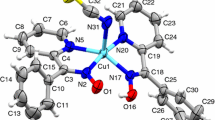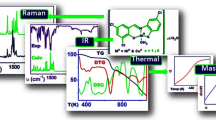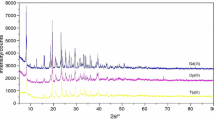Abstract
The [Cu(pydc)(eim)3]·H2O (1), [Cu(pydc)(4hp)(H2O)] (2) and [Ni(pydc)(3hp)(H2O)2][Cu(pydc)(3hp)(H2O)2]·3H2O (3) complexes (H2pydc = 2,6-pyridinedicarboxylic acid or dipicolinic acid, eim = 2-ethylimidazole, 4hp = 4-hydroxypyridine, 3hp = 3-hydroxypyridine) were studied by thermo-gravimetric analysis at an ambient temperature up to 1000 K under nitrogen atmosphere. The complexes are stable about 350 K, and the decomposition reactions were carried out in seven, three and four stages for the complexes 1, 2 and 3, respectively. Following detailed thermo-gravimetrical analysis of the complexes, the decomposition mechanism was suggested for all complexes. The kinetic analysis of all decomposition stages of each compound was performed except for the final stages. The values of the activation energy, E a, were obtained using model-free Kissinger–Akahira–Sunose and Flyn–Wall–Ozawa methods for all decomposition stages.











Similar content being viewed by others

References
Batten SR, Robson R. Interpenetrating nets: ordered, periodic entanglement. Angew Chem Int Ed. 1998;37:1460–94.
Murray LJ, Dincă M, Long JR. Hydrogen storage in metal–organic frameworks. Chem Soc Rev. 2009;38:1294–314.
Li JR, Kuppler JR, Zhou HC. Selective gas adsorption and separation in metal–organic frameworks. Chem Soc Rev. 2009;38:1477–504.
Ferey G. Hybrid porous solids: past, present, future. Chem Soc Rev. 2008;37:191–214.
Zheng SL, Chen XM. Recent advances in luminescent monomeric, multinuclear, and polymeric Zn(II) and Cd(II) coordination complexes. Aust J Chem. 2004;57:703–12.
Maspoch D, Ruiz-Molina D, Veciana J. Old materials with new tricks: multifunctional open-framework materials. Chem Soc Rev. 2007;36:770–818.
Maspoch D, Ruiz-Molina D, Veciana J. Magnetic nanoporous coordination polymers. J Mater Chem. 2004;14:2713–23.
Batten SR, Murray KS. Structure and magnetism of coordination polymers containing dicyanamide and tricyanomethanide. Coord Chem Rev. 2003;246:103–30.
Kitagawa S, Noro SI, Nakamura T. Pore surface engineering of microporous coordination polymers. Chem Commun. 2006;7:701–7.
Kepert CJ. Advanced functional properties in nanoporous coordination framework materials. Chem Commun. 2006;7:695–700.
Kitagawa S, Uemura K. Dynamic porous properties of coordination polymers inspired by hydrogen bonds. Chem Soc Rev. 2005;34:109–19.
Wang L, Duan L, Wong E, Xiao D, Li Y, Lan Y, Xu L, Hu C. Novel hydrogen-bonded three-dimensional network complexes containing cobalt-pyridine-2,6-dicarboxylic acid. Transit Met Chem. 2004;29:212–5.
Yang LQ, Crans DC, Cour A, Anderson OP, Kaszynski PM, Godzala ME, Austin LD, Willsky GR. Cobalt(II) and cobalt(III) dipicolinate complexes: solid state, solution, and in vivo insulin-like properties. Inorg Chem. 2002;41(19):4859–71.
Sileo EE, Blesa MA, Rigotti G, Rivero BE, Castellano EE. The crystal chemistry of copper(II) dipicolinates. Polyhedron. 1996;15(24):4531–40.
Ma C, Chen C, Liu Q, Liao D, Li L. The first structurally characterized trinuclear dipicolinato manganese complex and its conversion into a mononuclear species by ligand substitution. Eur J Inorg Chem. 2003;6:1227–31.
Ranjbar M, Aghabozorg H, Moghimi A. A seven-coordinate pyridine-2,6-dicarboxylate-bridged cadmium(II) complex, at 110 K. Acta Crystallogr. 2002;E58:m304.
Devereux M, McCann M, Leon V, McKee V, Ball RJ. Synthesis and catalytic activity of manganese(II) complexes of heterocyclic carboxylic acids: X-ray crystal structures of [Mn(pyr)2]n, [Mn(dipic)(bipy)2]·4.5H2O and [Mn(chedam)(bipy)]·H2O (pyr = 2-pyrazinecarboxylic acid; dipic = pyridine-2,6-dicarboxylic acid; chedam = chelidamic acid(4-hydroxypyridine-2,6-dicarboxylic acid); bipy = 2,2-bipyridine). Polyhedron. 2002;21:1063–71.
Ma C, Fan C, Chen C, Liu Q. Aqua(dipicolinato-3O2, N, O6)(1,10-phenanthroline-2N, N′)manganese(II) monohydrate. Acta Crystallogr C. 2002;58:m553–5.
Koman M, Melnik M, Moncol J. Crystal and molecular structure of copper(II)(pyridine-2,6-dicarboxylato)(2,6-dimethanolpyridine). Inorg Chem Commun. 2000;3:262–6.
Mao L, Wang Y, Qi Y, Cao M, Hu C. A novel three-dimensional supramolecular framework with one-dimensional channels: synthesis and crystal structure of [Cu(DPC)(H2O)3] (H2DPC = Pyridine-2,6-dicarboxylic acid). J Mol Struct. 2004;688:197–201.
Udo S. Chemical constituents of Natto, fermented soybeans. I. The occurrence of dipicolinic acid in natto and its behavior on micro. ovrddot. organisms. J Agr Chem Soc Jpn. 1936;12:386–94.
Powell JF, Strange RE. Biochemical changes occurring during the germination of bacterial spores. Biochem J. 1953;54(2):205–9.
Singh RP. Studies with picolinamide on development of thermo resistance in bacilli. Curr Sci. 1987;56:1232–4.
Crans DC, Mahroof-Tahir M, Johnson MD, Wilkins PC, Yang LQ, Robbins K, Johnson A, Alfano JA, Godzala ME, Austin LT, Willsky GR. Vanadium(IV) and vanadium(V) complexes of dipicolinic acid and derivatives. Synthesis, X-ray structure, solution state properties: and effects in rats with STZ-induced diabetes. Inorg Chim Acta. 2003;356:365–78.
Crans DC, Yang LQ, Alfano JA, Chi LAH, Jin WZ, Mahroof-Tahir M, Robbins K, Toloue MM, Chan LK, Plante AJ, Grayson RZ, Willsky GR. (4-Hydroxypyridine-2,6-dicarboxylato)oxovanadate(V)—a new insulin-like compound: chemistry, effects on myoblast and yeast cell growth and effects on hyperglycemia in rats with STZ-induced diabetes. Coord Chem Rev. 2003;237:13–22.
Willsky GR, Chi LH, Godzala M, Kostyniak PJ, Smee JJ, Trujillo AM, Alfano JA, Ding W, Hu Z, Crans DC. Anti-diabetic effects of a series of vanadium dipicolinate complexes in rats with streptozotocin-induced diabetes. Coord Chem Rev. 2011;255:2258–69.
Chatterjee M, Maji M, Ghosh S, Mak TCW. Studies of V(III) complexes with selected α-N-heterocyclic carboxylato NO donor ligands: structure of a new seven-coordinated pentagonal bipyramidal complex containing picolinato ligands. J Chem Soc Dalton Trans. 1998;21:3641–6.
Nathan LC, Mai TD. Influence of the spectator cation on the structure of anionic pyridine-2,6-dicarboxylato complexes of cobalt(II), nickel(II), and copper(II). J Chem Cryst. 2000;30(8):509–18.
Yang L, Crans DC, Miller SM, Cour A, Anderson OP, Kaszynski PM, Godzala ME, Austin LD, Willsky GR. Cobalt(II) and cobalt(III) dipicolinate complexes: solid state, solution, and in vivo insulin-like properties. Inorg Chem. 2002;41:4859–71.
Douki T, Setlow B, Setlow P. Photosensitization of DNA by dipicolinic acid, a major component of spores of Bacillus species. Photochem Photobiol Sci. 2005;4:591–7.
Laine P, Gourdon A, Launay JP. Chemistry of iron with dipicolinic acid. 2. Bridging role of carboxylate groups in solid state structures. Inorg Chem. 1995;34:5138–49.
Xie L, Wei Y, Wang Y, Hou H, Fan Y, Zhu Y. 2D and 3D binuclear cobalt supramolecular complexes: synthesis and crystal structures. J Mol Struct. 2004;692:201–7.
Qi Y, Wang Y, Fan H, Cao M, Mao L, Hu C, Wang E, Hu N, Jia H. Structure characterization and physical properties of a complex with supramolecular architectures Co2(2,6-DPC)2Co(H2O)5·2H2O (DPC 2,6-pyridinedicarboxylate). J Mol Struct. 2004;694:73–8.
Wang L, Duan L, Wang E, Xiao D, Li Y, Lan Y, Xu L, Hu C. Novel hydrogen-bonded three-dimensional network complexes containing cobalt-pyridine-2,6-dicarboxylic acid. Transit Met Chem. 2004;29:212–5.
Wang L, Duan L, Xiao D, Wang E, Hu C. Synthesis of novel copper compounds containing isonicotinic acid and/or 2,6-pyridinedicarboxylic acid: third-order nonlinear optical properties. J Coord Chem. 2004;57:1079–87.
Uzun N, Çolak AT, Emen FM, Kismali G, Meral O, Alpay M, Çılgı GK, Şahin E. The syntheses, crystal structure, thermal analysis, and anticancer activities of novel dipicolinate complexes. J Coord Chem. 2015;68(6):949–67.
Fernandes DM, Hechenleitner AAW, Pineda EAG. Kinetic study of the thermal decomposition of poly(vinyl alcohol)/kraft lignin derivative blends. Thermochim Acta. 2006;441:101–9.
Ak M, Çılgı GK, Kuru FD, Çetişli H. Thermal decomposition kinetics of polypyrrole and its star shaped copolymer. J Therm Anal Calorim. 2013;111:1627–32.
Çılgı GK, Cetişli H, Donat R. Thermal and kinetic analysis of uranium salts, part 2. Uranium(VI) acetate hydrates. J Therm Anal Calorim. 2012;110:127–35.
Kaljuvee T, Rudjak I, Edro E, Trikkel A. Heating rate effect on the thermal behavior of ammonium nitrate and its blends with limestone and dolomite. J Therm Anal Calorim. 2009;97:215–21.
Chaiyo N, Muanghlua R, Niemcharoen S, Boonchom B, Seeharaj P, Vittayakorn N. Non-isothermal kinetics of the thermal decomposition of sodium oxalate Na2C2O4. J Therm Anal Calorim. 2012;107:1023–9.
Vecchio S, Materazzi S, Kurdziel K. Thermal decomposition kinetics of palladium(II) 1-allylimidazole complexes. Int J Chem Kinet. 2005;37:667–74.
Cilgi GK, Cetişli H. Thermal decomposition kinetics of aluminum sulfate hydrate. J Therm Anal Calorim. 2009;98:855–61.
Favergeon L, Pijolat M, Helbert C. A mechanism of nucleation during thermal decomposition of solids. J Mater Sci. 2008;43:4675–83.
Koga N, Tanaka H. A physico-geometric approach to the kinetics of solid-state reactions as exemplified by thermal dehydration and decomposition of inorganic solids. Thermochim Acta. 2002;388:41–61.
Cetişli H, Çılgı GK, Donat R. Thermal and kinetic analysis of uranium salts, part 1. Uranium (VI) oxalate hydrates. J Therm Anal Calorim. 2012;108:1213–22.
Acknowledgements
This work was supported by Dumlupinar University, Project No. 2012/22.
Author information
Authors and Affiliations
Corresponding author
Rights and permissions
About this article
Cite this article
Uzun, N., Çolak, A.T., Emen, F.M. et al. The thermal and detailed kinetic analysis of dipicolinate complexes. J Therm Anal Calorim 124, 1735–1744 (2016). https://doi.org/10.1007/s10973-016-5251-y
Received:
Accepted:
Published:
Issue Date:
DOI: https://doi.org/10.1007/s10973-016-5251-y



